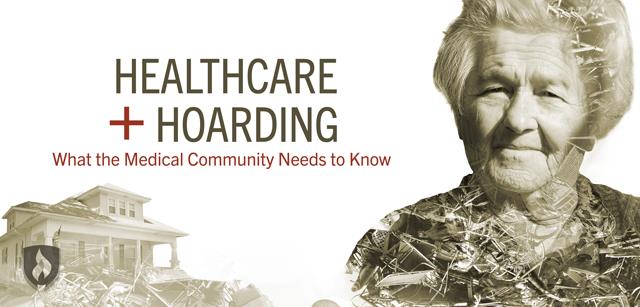Healthcare & Hoarding Disorder: What the Medical Community Needs to Know
By Kristina Ericksen on 01/18/2016

Piles of papers. Boxes of books. Stacks of stuff. Homes creaking and groaning under the unbearable weight of years of accumulation. This is the stark imagery of hoarding disorder, and it’s a reality for as many as three million Americans.
When it’s not just an overflowing junk drawer anymore, hoarding comes creeping into every corner of a person’s living space, bringing with it a multitude of physical and emotional damage. And it’s becoming more common.
With the population aging, hoarding – a problem that emerges with force in elderly communities — is becoming increasingly prevalent. Many times the nurses, home aides and healthcare professionals who work closely with elderly patients end up at the frontline for recognizing hoarding signs and behaviors.
Keep reading to learn about this devastating disease and find out how you can step in to help a hoarder seek the treatment they need.
What is hoarding disorder?
Hoarding disorder has three main characteristics:
- One must keep many possessions, even those of seemingly little value.
- These possessions clutter living spaces and prevent their intended use.
- These possessions cause distress and disrupt day-to-day living.
Hoarding disorder’s secretive nature makes it hard to account for just how many people are suffering from the disease. Many cities don’t even track occurrences of hoarding. However, communities across the US have witnessed increases in hoarding incidents and some are responding with task forces to address the problem.
What are some characteristics of hoarders?
While hoarding disorder may appear as early as in the teenage years, it grows more prevalent throughout adulthood and in the elderly. Serious hoarding disorder affects one in every 50, though the disorder may affect as many as one in 20. With the population aging, hoarding becomes a bigger problem as it affects more and more seniors.
"The biggest misconception is that the person is lazy or chooses to live this way."
“The biggest misconception about hoarding is that the person is lazy or chooses to live this way,” says Matt Paxton, from the Lifetime TV show Hoarders: Family Secrets and extreme cleaning expert at ServiceMaster Restore. He explains that hoarding is not a choice; it’s a mental disorder. Most sufferers want to get their lives back but their brains won’t allow them to just throw things away.
Hoarding is linked to many mental health concerns. Those with Alzheimer’s and 20 percent of dementia patients suffer from hoarding. About one-fifth of hoarders also meet criteria for Obsessive Compulsive Disorder (OCD). Additionally, it’s linked to depression, anxiety and other social disorders.
Hoarders often live alone. With no roommates or family to curtail their impulses, their possessions grow and further their isolation. They may also exhibit perfectionist tendencies. They may be indecisive or impulsive. They may have survived a traumatizing experience in life, though it’s important to remember that all hoarders and types of hoards are different.
The true cost of hoarding
Hoarding disorder comes at many costs. It’s an immense emotional burden on the hoarder and their loved ones. Maintenance and upkeep can go neglected in homes buried under a hoard. Not to mention the hoard itself bears a heavy weight on the structure of homes and may even result in eviction and homelessness.
Read on for a closer look into the repercussions of this disease.
Personal health effects
The environment of a hoard can be detrimental to personal health. Respiratory problems are common in hoarders. Decaying conditions of the home can lead to infestations. Lack of sanitation, mobility and maintenance reduces the quality of life of a hoarder. Unsafe living quarters make hoarders, especially elderly hoarders, vulnerable to slips and injuries.
“The number one health concern I see most often with elderly hoarders is related to tripping and falling,” Paxton says. “Another big issue we see is infection.” He says he’s encountered many elderly clients whose cuts and bruises become infected and don’t heal due to the hazardous condition of the home.
Safety concerns
Hoarding poses the risk of inaccessibility to homes in the case of an emergency. Piles of possessions are liable to collapse. Buckling floors, blocked exits and faulty electricity all pose additional threat to hoarders. And they’re particularly at risk of fire. In one Pennsylvania community, 20 percent of fire calls featured hoarding conditions. These safety concerns affect entire communities, especially when hoarders live in apartment or condo units.
Financial burdens
For hoarders seeking help, professional clean-up services are expensive, especially for older hoarders on a fixed income. If they’re not able to foot the bill, public agencies may have to pay to haul out the hoard, clean the premises and provide housing in the process, draining their own funds.
Hoarders who are removed from their home or evicted from rentals cost landlords, county agencies and individuals millions of dollars, according to a San Francisco case study. That’s a price society pays.
Working with hoarders
The nature of hoarding disorder requires an array of resources. Everyone from therapists and psychiatrists to organizers and cleaners do their part to address the layered problems of hoarding. Adult protective services, fire departments, social workers, city code enforcement, nurses and home healthcare workers add to the mix as well.
But it is often the visiting nurses or home aides who get the first glimpse of a hoarding problem. These professionals aren’t trained in working with hoarders. They usually don’t have much experience working with mental illness, but they can play a critical role in keeping their patient safe and getting them the help they need.
What can healthcare professionals do?
If you’re on the frontline of healthcare, you may recognize hoarding behaviors in your patients, especially if you work in geriatrics or with elderly demographics. But you’re not a psychiatrist, and you probably don’t specialize in mental health. So what can you do?
“Nurses can play a huge role in recognizing hoarding within various healthcare settings. As patients may not view this condition as a problem, it is important to be cognizant of the symptoms,” says Jared Heathman, MD of Your Family Psychiatrist, PLLC.
If you’re seeing signs of hoarding in a patient – living spaces cluttered with possessions, difficulty completing day to day tasks or excessive attachment to material objects – take action.
Tips for working with hoarders
We spoke with an array of experts on hoarding, including therapists, organizers and cleaning experts. Here’s what they recommend:
- Be straightforward: “The best way to approach someone suffering with hoarding is to be honest and upfront,” Paxton says. “Don’t beat around the bush.”
- Gain their trust: “A person must manage their reactions when working with someone with hoarding issues,” says Linda Buscemi, principal of the Geriatric Institute and Arizona hoarding task force chair member. She recommends always using respectful language, with non-judgmental words and body language.
- Check your judgment: “Have no judgment. Be very kind and offer choices,” says professional organizer Leslie Jacobs. “The person who hoards is very territorial,”
- Approach with caution: “Do not touch their objects or make immediate suggestions. Use their language regarding their items,” says Buscemi. Even if the items seem like trash to you, remember they are valued belongings to them.
- Give them a sense of control: “Don’t force an ultimatum or do a surprise cleanout. People suffering with hoarding have lost control at some point in their life and hoarding gives them a sense of control,” Paxton explains. Taking the control away only pushes them deeper into the disorder.
- Understand their thinking: “You must remember that people who hoard process information differently. They likely have poor insight into the danger of their hoarding issue. They will resist clean ups and do not think any one understands how valuable their stuff is,” Buscemi says.
- Bring in the experts: “As hoarding can be a long-term disorder resulting in dysfunction, it is important to address concerns with the entire medical team,” Heathman says. Treatment may need to include psychiatric and psychological services.
- Make them aware: “Just cleaning the home will not solve the problem,” Buscemi warns. “It is a long and slow process. The first step is for them to be aware and work on a plan together on how to clean up their home and reconcile their thoughts.”
Now you know…
Hoarding disorder comes in many different levels, but the devastating effects remain the same. Anyone can develop hoarding tendencies, but its prevalence in the elderly community is hard to ignore. If you recognize signs of hoarding disorder in a patient of yours, a friend or a family member, step in and offer to help them seek the treatment they need.




